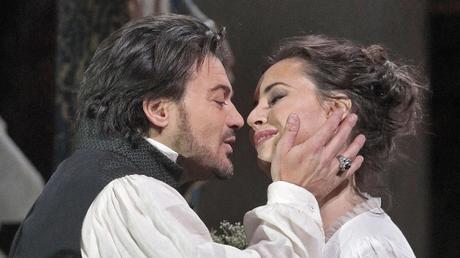 Vittorio Grigolo as Cavaradossi & Sonya Yoncheva as Tosca in rehearsal for David McVicar’s new production of Tosca (Photo: Ken Howard/Metropolitan Opera)
Vittorio Grigolo as Cavaradossi & Sonya Yoncheva as Tosca in rehearsal for David McVicar’s new production of Tosca (Photo: Ken Howard/Metropolitan Opera)Imitation: The Sincerest Form of Flattery
Lately, Scottish opera and theater director Sir David McVicar has been serving as a viable alternative to Franco Zeffirelli and other directors as the production designer of choice at the Metropolitan Opera. This season, the Met has staged new productions and revivals of several of Mr. McVicar’s directorial efforts, including back-to-back broadcasts of Puccini’s Tosca on January 27, 2018, and the February 3rd radio transmission of Verdi’s Il Trovatore.
It is fascinating to note that at one time, Verdi had shown an inclination to tackle French playwright Victorian Sardou’s five-act tragedy La Tosca, but due to his advanced age decided against it. A rival composer, Alberto Franchetti, under contract to music publisher Giulio Ricordi, was tricked into giving up the rights to the play by both Ricordi and Puccini, the fellow who ultimately wrote the score. They were aided and abetted by librettist Luigi Illica, who had submitted a working scenario of the piece.
Along with his co-librettist, poet Giuseppe Giacosa, the duo sliced and diced, as well as pruned away vast quantities of expository dialog from the overly-wordy play. The final draft, excluding a long-winded third-act ode to art for Cavaradossi, formed the gist of the libretto we know today as Tosca. Puccini’s music reflects the rapid nature of the plot, which takes place over a 24-hour period.
The opera proper begins with the thunderous three-note chords of the brutal Scarpia’s motif. Some listeners, including this writer, feel there are five notes attached to his theme. Nevertheless, it’s a forceful beginning to a rapidly advancing story line — the better to put aside the eccentricities of the plot, which skirts the fringes of the obvious and outlandish.
At the start of Tosca, there were extraneous stage noises and grousing from the strong-voiced baritone Patrick Carfizzi as the Sacristan. His mumbling and grumbling drowned out the lilting rhythmic tune that accompanies his footsteps. Before the Sacristan’s emergence, however, bass Christian Zaremba sounded out of breath and at the end of his rope as the escaped political prisoner Angelotti — quite appropriate for someone fleeing the Roman police. Angelotti’s perilous situation gets the story moving from the first minutes he is on stage.
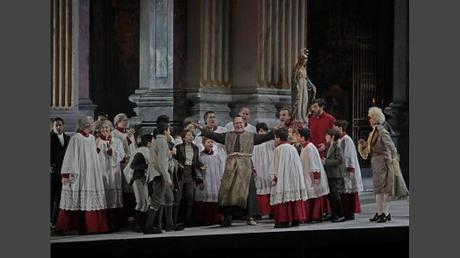
Of course, everyone waits with bated breath for the tenor to make his entrance. He did not disappoint. Italian matinee idol Vittorio Grigolo’s light-voiced, Pavarotti-like timbre was a plus in his role debut as the handsome painter-cum-revolutionary Mario Cavaradossi, a thoroughly romanticized portrait. But how would he compare to the dark-toned Jonas Kaufmann, who was originally slated for this part until Kaufmann opted out of his contract? Quite well was the final verdict. In fact, Grigolo brought to mind some noteworthy Cavaradossis, including the even lighter-toned Ferruccio Tagliavini, and the much admired Fernando De Lucia.
The raked and tilted stage platform (the sets and costume designs were the work of John Macfarlane) presented a skewed view of Tosca’s world. The period costumes lent authenticity to McVicar’s more traditional touches.
The French-born conductor Emmanuel Villaume led the Met Opera Orchestra in a most indulgent manner. His leisurely accompaniment slowed the pace in Act I, but picked up immeasurably in the heightened pulsations of Act II, the dramatic and emotional climax of the work.
This was also Bulgarian soprano Sonya Yoncheva’s role debut as Tosca. She was a substitute for the Latvian Kristine Opolais, who had dropped out of the production, taking her husband, conductor Andris Nelsons, with her. Nelsons’ pinch-hitter, former music director James Levine, also removed himself from contention due to late-inning accusations of sexual assault.
Callas-like, headstrong, and by turns equally amorous and playful, applause greeted both Yoncheva and Grigolo’s entrances. Yoncheva certainly captured Floria Tosca’s jealous nature and love of life with full-toned abandon. She suggested a more restrained delivery of the text than the norm, although in truth her Italian vowels needed a cleaner and rounder definition. She has the range required and sufficient color in the voice to encompass her character’s mood swings (a frequent occurrence in Act II).
Grigolo was the perfect partner for Yoncheva’s Tosca. Dashing and handsome, he was also good humored. His first aria, “Recondita armonia,” where the painter compares the various features of his portrait of Mary Magdalene to that of his lover Tosca, was superbly realized. He even took the phrase “S’affisa intero; occhio all’amor soave,” during his first act duet with Tosca, in a single breath. I wondered if he was going to make it through to Act III (especially during a potent, full-throttle shout of “Vittoria!” after his second-act torture sequence).
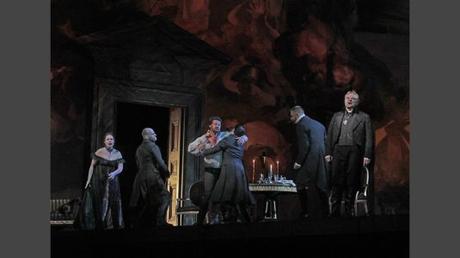
For her side, Yoncheva was able to get in touch with her inner Maria Callas, turning the spigot on full blast in the opera’s later acts, but minus that singer’s notorious wobbles. And indeed, hers was a Tosca very much in the Callas mold, as the broadcast of Bellini’s Norma had earlier indicated (see the following link to my review: https://josmarlopes.wordpress.com/2017/12/25/casta-diva-bellinis-norma-tries-for-a-comeback-at-the-met/). The late, great diva Maria Callas has been a pivotal role model for young artists for many, many seasons. And she continues to exert a strong pull to this day.
Tempestuous and temperamental, with raw emotion on permanent display, Sonya’s middle voice evoked memories of La Divina. I don’t know if this was coincidental or deliberate on her part. However, it may be disadvantageous to Yoncheva in the long run to be associated with the Callas style. It certainly hasn’t been detrimental to her colleague, Sondra Radvanovsky, whose Tosca was the embodiment of grand opera singing. In so much as they may learn from their illustrious predecessor, both artists at some point will need to forge their own individual identities.
I detected a wobble on her highest note in Tosca’s iconic aria, “Vissi d’arte” (“I live for art”). But otherwise, Yoncheva turned out to be a believable diva. This is one of those roles where an opera star gets to play an opera star. (Author’s note: In Sardou’s play, Tosca is coached by composer Giovanni Paisiello). We make note of a curiosity: for the first time in my live listening experience, the short snippet of phrases spoken by Scarpia (“Risolvi?” – “Is your mind made up?”); and Tosca (“Mi vuoi supplice ai tuoi piedi” – “See, I am begging at your feet”) following her aria, normally cut in performance were heard. Lasting no more than a few seconds, it goes to McVicar’s respect for the composer’s intentions, demonstrated in the same director’s Cavalleria and Pagliacci production which restored formerly excised material. This may have been a Met Opera first. Score one for completists!
The Bad Guy You Love to Hate
Serbian baritone Željko Lučić, a substitute for Bryn Terfel, another defector from this new production (this time due to vocal problems), sang Baron Scarpia. He sounded soft-grained in Act I, his notes coming up from below instead of head on. His verbal attacks were mushy and indistinct, and needed a pointedly sharper conveyance of the all-important text to make an effect. He was less impressive in the concluding Te Deum, where Scarpia blames Tosca for making him forget God (it’s all her fault, you know — I wonder what the police chief would say about the #MeToo movement). He needed to dominate the ecclesiastical proceedings, which concludes with sonorous replications of the Scarpia motif, heard throughout the opera in various forms.
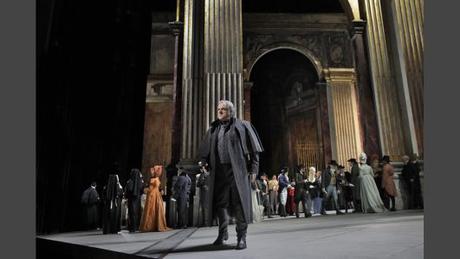
Lučić was markedly better in Act II, expanding the line and range of his voice, and letting it ring out with more abandon and in less opaque a fashion than he had previously. This made his character’s villainy all the more plain. But when things started to spin out of control this Scarpia hurled his threats and frustrations at anyone in sight and in ever-mounting rage.
In his and Tosca’s long second-act duel of wills, Lučić roused himself from his first-act stupor. Transformed into an insidious lecher (the “bigoted satyr” described by Cavaradossi early on), Lučić’s Scarpia enjoyed toying with his quarry, the harried and cornered opera diva, Tosca. He took a divergent perspective from George Gagnidze, his predecessor in the part in the disastrous Luc Bondy production, mercifully put out to pasture. Gagnidze pummeled the opposition in no-holds-barred mode, whereas Lučić took an understated approach. At first, he turned on the charm before revealing his debauched nature. Somebody stop this guy!
He did have some trouble with high notes, and was under the pitch throughout many passages. True, the on-air volume levels were frequently adjusted (lots of meddlesome knob turning) to conform to the sound engineer’s taste. This detracted at times from my enjoyment of the performance as a whole, but did not completely damage it.
I couldn’t tell if Scarpia went off to look at the birds, as the late baritone Tito Gobbi used to complain about at this point in the story. Chalk it up to the conductor, maestro Villaume, who paused at strategic points in Act II to allow the drama to hit with added force. One example turned out to be the unusually long break before Scarpia’s “E bene?” query (“Well, then?”), prior to Tosca consenting to give him her body in exchange for her lover’s life. The chief of police’s death rattle was exceptionally effective, with both Lučić and Yoncheva responding to each other’s prompts, and Villaume in support of their onstage chemistry. Their battle of wits was the best part of the show.
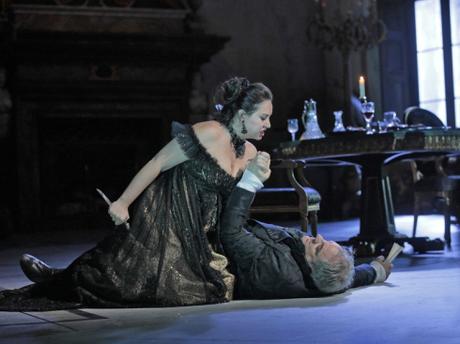
In Act III, Villaume led a marvelously evocative introduction, the woodwinds, double basses, and horns all in concert with each other and contributing to an aural picture of sunrise over Rome. The boy soprano, singing an engaging shepherd’s song in authentic Roman dialect, along with a myriad of bell sounds, each tuned to precisely the ones used in the Eternal City’s churches, was one of several sonic instances of scene painting. Absolutely fabulous! But what dramatic purpose do they all serve? For the reasons behind this musical interlude, we quote from William Berger’s Puccini without Excuses:
“[T]he intermezzo was a stock-in-trade of the verismo school, made indispensable by the success of the intermezzo in Pagliacci and the wildly popular one in Cavalleria Rusticana. The idea of ‘pure music’ was understood as a component of dramatic truth, another chance for ‘modern’ Italian composers to distance themselves from the conventions of bel canto, and even perhaps a nod to French and German trends in opera at the time.” (Berger, William. Puccini without Excuses, p. 103).
For Cavaradossi’s third act farewell to his lover and his life, “E lucevan le stelle,” Grigolo’s long-held diminuendo, carried out (again) on a single breath of air, was a thrilling yet heart-breaking moment. The ovation he received afterwards was well deserved. I still find his tenor two shades too light for verismo, but with age and experience Grigolo might meld into a sprightly spinto of distinction.
It was here that I also noticed another deviation from standard performance practice: when Tosca comes to show Cavaradossi the good conduct letter that Scarpia had signed (prior to her killing him), soprano and tenor did not join together as tradition dictates, but Yoncheva alone sang the line, “E al cavaliere che l’accompagna” (“And the gentleman to accompany her”). One is tempted (in Watergate-style fashion) to ask, “What did the composer write and how did he want it to be sung?” We may never know. But one may be witnessing the dawn of a new era, one where the will of the composer may be taking precedence over mindless “tradition.”
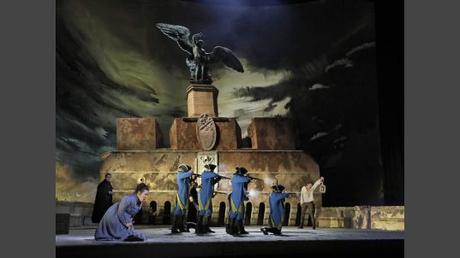
Despite Tosca’s assurances that he will escape death by firing squad, Cavaradossi instinctively senses this will be their final moments together. Consequently, their triumphant shout of “Difonderem!” on high C celebrates the couple’s all-consuming passion for one another, even in the face of his imminent demise. This duet, written sometime in 1899 before the opera’s premiere in January 1900, may remind listeners of the exciting conclusion to Giordano’s Andrea Chénier, which premiered four years earlier at La Scala on March 28, 1896.
The action moves swiftly at this point to its crushing conclusion. Puccini provides audiences with the final line from the painter’s sorrowful tune: “E non ho amato mai tanto la vita!” (“And never have I loved life more than I do now!”), the Italianate version of a slow-motion march to the scaffold (compare this ending with one that Hector Berlioz conjured up for his Symphonie fantastique).
Christopher Job provided the wobbly Sciarrone, and Brenton Ryan made for a shaky-voiced Spoletta. Within the context of the drama, and the fact that their boss was the intimidating chief of police, they were perfectly justified in their reactions. Richard Bernstein sang the part of the jailer. In all, this was a most auspicious reading of one of Puccini’s most frequently performed works.
So how did Il Trovatore, another of David McVicar’s Met presentations, hold up? Stay tuned for the next installment!
End of Part One
(To be continued….)
Copyright © 2018 by Josmar F. Lopes
Advertisements &b; &b;
